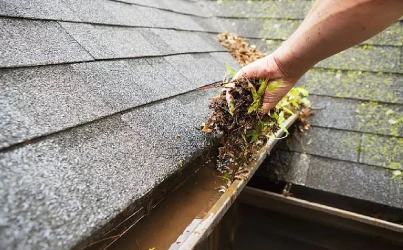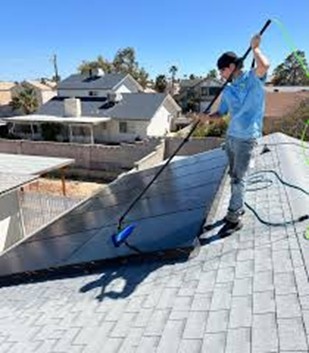
Summer can be brutal on rooftops. Heat, humidity, and moisture are the perfect recipe for rapid growth of mold, mildew, and algae, especially on the north-facing or shaded parts of your roof. And the longer these contaminants sit, the worse the damage becomes.
Here’s why acting now before fall is crucial:
In hot weather, organic material on your roof doesn’t just sit there. It cooks into the surface. Once baked in, stains become more difficult to remove, and the risk of long-term shingle damage increases. Think of it like letting food burn onto a pan - it becomes hard to remove and potentially damaging.
By hiring a professional for soft washing now, you stop the damage in its tracks and prevent ugly, set-in stains that become tougher to remove later.
As humidity peaks in late summer, mold and algae spread more quickly than at any other time of year. If you leave them untreated, they can multiply across your roof and solar panels, damaging materials and dragging down energy efficiency.
Specialized cleaning eliminates this biological growth at the source, leaving surfaces cleaner and more resistant to future outbreaks.
Late summer is prime time for outdoor events: Labor Day parties, back-to-school BBQs, family reunions, and neighborhood get-togethers. If you’re hosting, your home’s appearance matters and that includes what guests see when they look up.
Maybe you’re planning to list your home before the fall real estate market cools down. A stained roof or grimy solar panels can turn buyers off immediately or make them wonder what other maintenance was ignored. Professional cleaning instantly boosts curb appeal and can even increase perceived property value.
Solar panels are made to harness the sun’s energy but not if they’re covered in dirt, pollen, or mildew. Many homeowners don’t realize that even a light layer of grime can block sunlight and reduce efficiency by 10% to 30%.
What’s worse, using the wrong cleaning method like high-pressure water or harsh chemicals can void your warranty or damage the panels.
Professionals that use purified water systems and non-abrasive detergents can gently lift away contaminants without scratching or damaging the glass. A clean panel produces more energy, works more efficiently in the heat, and looks better too especially when your guests are admiring your eco-conscious lifestyle.
Delaying the cleaning of your roof and solar panels until fall might seem like a minor oversight, but the consequences can build up quickly and cost you more in the long run.
Algae, such as Gloeocapsa magma feed on the limestone filler in asphalt roofing, gradually breaking down its structural integrity. The longer this is left untreated, the more it compromises the lifespan and effectiveness of the roofing material. At the same time, solar panels coated with dirt, dust, or biological growth not only lose efficiency due to blocked sunlight but also retain excess heat. This retention leads to what's known as thermal degradation, putting unnecessary stress on the internal components and shortening the system’s performance life.
Additionally, as the weather cools and leaves begin to fall, the buildup of organic debris and moisture creates the perfect environment for moss to take root, especially in shaded areas. Moss can grow quickly and aggressively, embedding itself between shingles and under edges, eventually leading to water intrusion and rot.
Compounding the issue, grime that’s been baked onto surfaces during the summer becomes far more difficult to remove once it’s sealed in by autumn debris or winter frost, often requiring stronger chemicals or more intensive treatments. Taking action now prevents this cycle of damage before it starts, saving money, protecting materials, and keeping your home in peak condition.

Roofs: Every 1–2 years, depending on location, shade coverage, and local humidity levels.
Solar panels: Ideally once a year, or more often in dusty, pollen-heavy, or tree-filled areas.
Late summer is the perfect time for your annual or semi-annual cleaning, especially before fall leaves and rain cause debris buildup and blockage.
Here’s what homeowners can expect from this type of service:
Your roof and solar panels are two of the most exposed and valuable parts of your home. By late summer, they’ve already taken a beating from months of heat, storms, and humidity. Waiting until fall could mean letting mold and grime settle in, reducing performance, or even causing costly damage.
Mold and mildew love the combination of lingering summer heat and increased fall moisture. Once embedded, they become tougher to remove, degrade roofing materials, and can even void certain manufacturer warranties if not properly maintained.
Now is the ideal time to act.
It's a simple, proactive step that can prevent expensive repairs, maximize energy returns, and keep your home looking its best, whether you're staying in for the season or getting ready to sell.